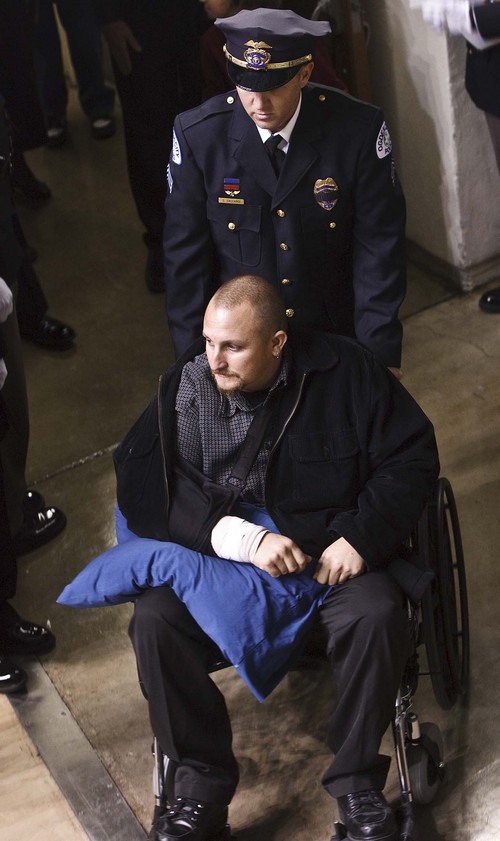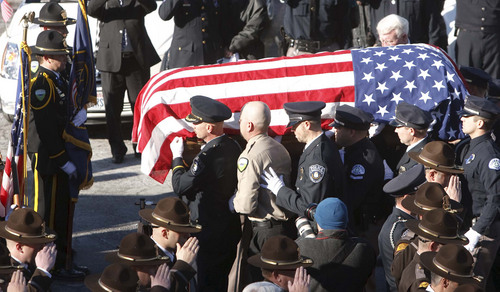This is an archived article that was published on sltrib.com in 2014, and information in the article may be outdated. It is provided only for personal research purposes and may not be reprinted.
Ogden • Police Chief Mike Ashment had a difficult task before him: In the aftermath of a shootout in which one of his officers was killed and several others were wounded, he had to identify where the officers went wrong — even though, in his mind, they were heroes.
"Once this thing went sideways, they did everything heroic, and over and above, [they] performed outstanding things," Ashment said of the January 2012 shooting that erupted as Weber-Morgan Narcotics Strike Force agents served a knock-and-announce warrant at an Ogden home.
But Ashment acknowledged that the officers made mistakes both before and during the drug raid on Matthew David Stewart's Jackson Avenue home. He said this week that he believes those mistakes were due to complacency — that the officers who entered Stewart's home that Jan. 4, 2012, evening thought they would find an empty grow house, not an armed man.
"This is a guy who is considered a low-level marijuana guy," the Ogden chief said. "And we let our guard down. ... We didn't go there prepared for a gunbattle."
A summary of the police agency's internal shooting review report, released this week as part of a Salt Lake Tribune open-records request, shows that many policy violations — including that some officers were not wearing bulletproof vests — occurred because they thought no one would be home.
"It appeared that all, if not most, of the agents believed they would find the home vacant," the shooting report reads. "... [which] contributed to complacency in the use of standard equipment, approaching the target home safely, conducting a thorough background investigation of the suspect, and a thorough scout of the target home."
The report said that during two unsuccessful "knock-and-talk" attempts — when agents attempted to knock on Stewart's door to make contact with him — the same kitchen light was on. Agent Jason VanderWarf said in an interview with investigators after the shooting that they believed the light could have been on a timer, which indicated that no one actually lived there and it was just a "grow house."
Also, a so-called "pre-surveillance" of the home was supposed to have been conducted by a specific officer 30 to 60 minutes before the raid — but was never done. "If this task had been completed, it may have given an indication the suspect was inside the residence," the report says.
—
Violations • In addition to other errors, the report noted four violations of Ogden police policy and procedure:
• A sergeant on "light-duty status" should not have been at the raid, due to physical limitations. Sgt. Steve Zaccardi testified during Stewart's preliminary hearing that he had shoulder surgery a month prior and was wearing an arm sling during the raid. He stayed outside the home, he testified, and later left the scene to take an officer to the hospital.
• Five Ogden officers violated policy by failing to carry an extra fully loaded magazine. "Some agents ran dry of ammunition during the gunbattle and had to verbally announce that they were out, which most likely was heard by the suspect," the report says, adding that this also may have caused agents to advance toward gunfire to cover the retreat of other agents who were out of ammo.
• Four Ogden officers violated standard protocol by failing to carry their assigned police radios. This caused confusion, the report said, because information was not relayed efficiently and effectively to responding patrol officers.
• While it was not a "technical violation," several officers — including slain agent Jared Francom — did not wear bulletproof vests when entering the home. The report notes that at that time, the policy read that an officer "should" rather than "shall" wear a bulletproof vest. This policy has since been changed, requiring all field officers and any officer involved in a search warrant to wear body armor.
The report — which did not include names of the officers involved — said discipline for the officers ranged from a formal notice of caution to an entry in an officer's yearly performance evaluation.
The report also was critical about the lack of leadership once bullets started to fly. Two sergeants were on the scene, the report said, but when other officers responding to reports of an officer being shot arrived at Stewart's house, they didn't know who was in charge or where to go.
Zaccardi had left the scene to take a wounded officer to the hospital, and Sgt. Nate Hutchinson was inside the home when shots were fired.
"The sergeant [in the home] was very heroic," Weber County Attorney Dee Smith said. "He dragged two guys out and was shot four times."
But the report said there should have been an incident commander outside the home who could take control "once the situation deteriorated."
"It is likely that this would have identified evacuation points, medical staging areas and a safe route to the target location," the report reads.
—
Cross-fire • The potential for deadly crossfire — after Stewart left the home and holed up inside a shed — was created by the "lack of control and clear direction" at the scene, the number of officers arriving at the scene, and the number of bullets fired, the report says.
Forty-six rounds were fired by responding police officers outside of the home, with 32 of those fired toward the shed after Stewart climbed out a back window and retreated to his aluminum shed, the report said. These shots "creat[ed] a potential for friendly fire injuries," but an arriving supervisor soon gave orders that remedied the concern, the report said. No officers were wounded outside of the home, and none of the responding officers was disciplined, Ashment said.
The report said many of the bullets fired toward the shed went through it and struck Stewart's home and a neighboring home. One bullet went through the window of a neighboring home and lodged into a bedroom wall.
—
Investigation • The report also criticized the thoroughness of the investigation before the search warrant was ever executed. For instance, Stewart's ex-girlfriend, Stacy Wilson, who tipped police to the marijuana grow, had ample information about the layout of Stewart's home and whether he had violent tendencies, but she had not returned agent's calls for follow-up information after the initial tip, according to the report.
Even though the agents didn't know much about the home or who was inside it, Ashment said he believes the raid — which resulted in the seizure of 16 marijuana plants — should have gone forward.
"They had enough probable cause for a judge to issue a warrant," Ashment said. "You don't always have the benefit of every piece of information. But it's not uncommon in this profession for us to have to take risk. And in this case, that was the information they had and that's what they acted on."
VanderWarf testified during Stewart's preliminary hearing that during a "knock-and-talk" attempt he looked through a window on the south door of Stewart's home and saw items indicative of a marijuana grow, including evidence of humidifiers, bright lights and extension cords.
—
Policy changes • Twelve recommendations for policy changes were listed in the shooting review report, which Ashment said have been implemented. They include that officers receive more training, that pre-surveillance is required before serving a search warrant and that a supervisor who is not part of the entry team is on-scene.
It also became a requirement that all officers must wear "full entry gear" when entering a home during search warrant service, and that supervisors must do a gear check before entry.
Ashment said the policy changes have helped remedy issues of conflicting policies between police agencies that serve on the strike force, and also helped make officers safer. Francom's father, Jade Francom, complimented Ogden for investigating the shooting and instituting changes. He said the only person he blames for the death of his 30-year-old son, the father of two children, is Stewart.
"I love [the strike force officers] to death and it upsets me we've got everyone in the state playing armchair quarterback," Jade Francom said Wednesday.
The father also pointed out that Stewart's girlfriend did not tell police until after the shooting that Stewart said he would fire at police if they entered his home. He said knowing that could have produced "a totally different outcome."
Erna Stewart, Matthew Stewart's sister-in-law, said Wednesday that she felt the policy changes were "good," but not enough.
"I want to see a full revamp of how they police in our community," she said, adding that her family is opposed to police using "dynamic entry" to go into homes while serving search warrants.
The sister-in-law said she felt the most egregious error made by police was failing to do a thorough background check on Matthew Stewart — including learning about his habits and schedule.
"They took it too lightly," she said. "You are going into someone's house. People have guns. ... Had a team been fully trained, knew how to handle the situation, maybe Matthew would still be here. Maybe Jared would still be here."
Matthew Stewart was charged with capital murder for allegedly killing Francom and seven first-degree felony counts of attempted aggravated murder for allegedly trying to kill other officers.
He also was charged with one second-degree felony count related to alleged marijuana cultivation.
Stewart, 39, was awaiting trial in May 2013, when he hanged himself in his Weber County jail cell.
Erna Stewart said Wednesday she was disappointed that, in the aftermath of the shooting, the community was divided into "sides" — the police vs. Stewart's family and their supporters. She said she wants a healing process for everyone.
"We feel really badly," she said. "No one should have to go through what our families have been through."
—
Police militarization? • Stewart's family and supporters have criticized the raid, saying police have become over-militarized. But Ashment said the shooting review report shows just the opposite: that the officers did not have the equipment generally associated with "militarized" police.
"When you look at what happened, you take a step back and say, 'I wish we would have had [bulletproof] vests on everyone,' " Ashment said. "I wish we would have had shields. I wish we would have had helmets. Let me put it out there: We own our mistakes. We made changes. But this is not about an over-militarized police agency."
Partly in response to the shooting, Weber County police agencies have formed the "Tactical Operations Group." It includes the strike force members and officers from agencies throughout the county, who are specially trained and handle the execution of all search warrants in the county.
Though every search warrant is different, they also are wearing more gear than the officers who entered Stewart's home — likely including helmets, shields and heavier body armor.
Smith said Tuesday that the gear is not intended to harm homeowners or the public, but to protect officers.
"What people need to understand is that these are all defensive items," Smith said. "The shields — that's defensive, that's not offensive. That's to protect the officer in case another Matthew Stewart starts firing."
But Ashment said he worries that the public may misunderstand their efforts to protect their own.
"Am I concerned about public perception of police? Absolutely," he said. "We operate more effectively when the public supports the police. I think that if the public is better educated about why we do what we do, they will be more understanding of our equipment and tactics."
While Erna Stewart said she does believe SWAT tactics have a place when someone is in danger, she said her family doesn't support "military tactics," like breaking through a door to gain entrance into someone's home. The Tactical Operations Group, she said, "is the exact opposite" of what they have been pushing for.
The shooting review report notes that Smith found all officers who used their weapons during the raid at Stewart's home were justified in using deadly force because they "had reason to believe that both their lives and the lives of other officers were threatened by gunfire from the suspect."
Twitter: @jm_miller
Tribune reporter Nate Carlisle contributed to this story. —
Shooting report released after open-records request
Ogden's review of the Jan. 4, 2012, drug raid that resulted in one officer being killed and five others wounded was released to The Salt Lake Tribune earlier this week in response to an open-records request.
The Tribune requested internal police reviews in May 2013, shortly after Matthew David Stewart, who was charged with shooting the officers, committed suicide at the Weber County jail and his criminal case was closed. The police department denied the request, citing privacy issues.
The Tribune appealed the decision to Ogden's records review board — which also denied the request.
In February of this year, The Tribune filed a lawsuit in 2nd District Court seeking the report.
The release of the report — actually an eight-page summary of the internal reviews— was the result of out-of-court negotiations between the two parties after the lawsuit was filed.
The lawsuit will now be dismissed.
"Ogden and The Tribune worked together to resolve this records dispute in a way that acknowledged the city's privacy concerns but also enhanced public understanding of this tragic event," said Michael O'Brien, The Tribune's attorney. "This approach saved a lot of taxpayer dollars that might otherwise have been consumed in a lawsuit."



















